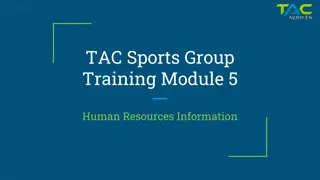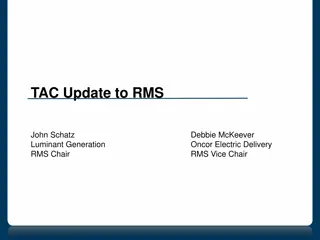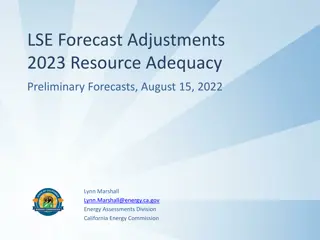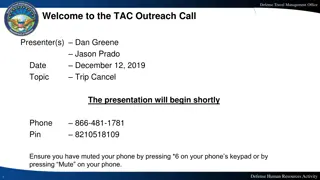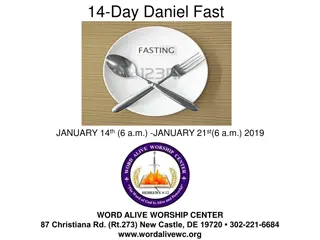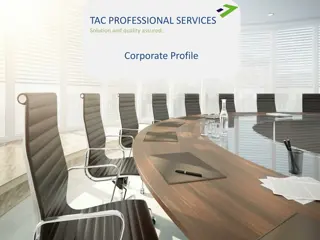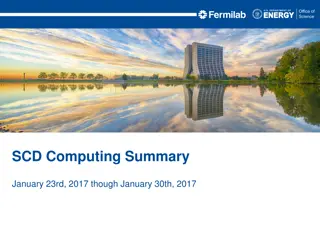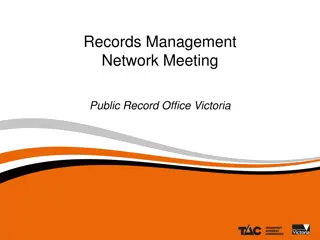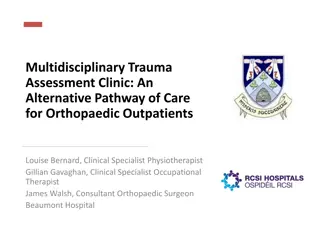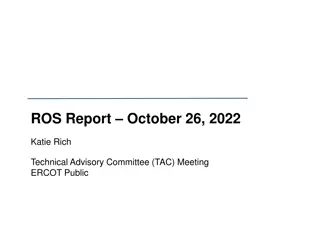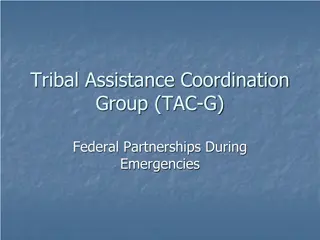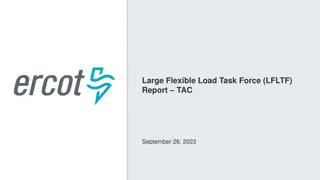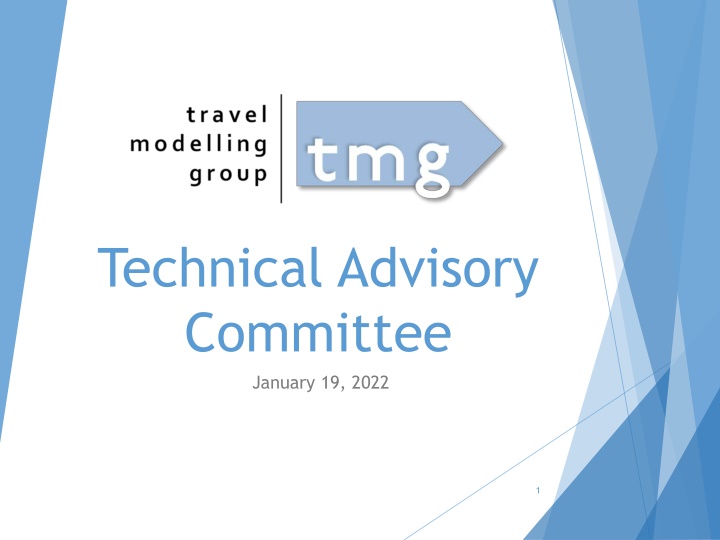
Technical Advisory Committee Meeting Agenda and Work Plan Updates
Get the latest updates from the Technical Advisory Committee meeting including the work plan for 2021-22, discussions on the Network Coding Standard 2022, and various task allocations. Issues to be finalized for the Network Coding Standard 2022 and VDF definitions are also highlighted.
Download Presentation

Please find below an Image/Link to download the presentation.
The content on the website is provided AS IS for your information and personal use only. It may not be sold, licensed, or shared on other websites without obtaining consent from the author. If you encounter any issues during the download, it is possible that the publisher has removed the file from their server.
You are allowed to download the files provided on this website for personal or commercial use, subject to the condition that they are used lawfully. All files are the property of their respective owners.
The content on the website is provided AS IS for your information and personal use only. It may not be sold, licensed, or shared on other websites without obtaining consent from the author.
E N D
Presentation Transcript
Technical Advisory Committee January 19, 2022 1
Agenda 2021-22 work plan update. Network Coding Standard 2022. Multi-year work plan discussion. 2022-23 meeting schedule. Other business. Adjournment. 2
2021-22 Work Plan Update TMG 2021-22 Work Plan MONTH Days Allocated No. TASK 1 GTAModel "C19" Version Development 2 Large-Scale Model System Calibration 3 Volume-Delay Function (VDF) Evaluation & Calibration2 4 Implementing Standard Accessibility Calculations3 5 Updated 2021 network coding standard 6 Development of a network repository 7 Development of Standard/Base Future Year Networks 8 Improved Non-Work/School Destination Choice Models4 9 Freight model improvements 10 GTAModel Maintenance & V4.3 Development 11 TMG Aimsun & Emme Toolbox Development & Maintenance 12 XTMF: Upgrades/ Maintenance & V2.0 Development 13 Documentation of TMG products 14 Outreach & Training (4 workshops) 15 Meetings: TMGSC (2) & TMGTAC (5) Apr 4 0.5 May 3 June 3 July 3 Aug 3 Sep 1 Oct 1 Nov 1 Dec 1 Jan Feb Mar 0.5 0.5 0.5 0.5 0.5 0.5 0.5 0.5 0.5 0.5 0.5 0.5 0.5 0.5 0.5 0.5 0.5 0.5 0.5 0.5 0.5 0.5 0.5 0.5 2 2 2 2 0.5 1.5 0.5 1.5 0.5 1.5 1.5 1.5 1.5 1.5 1 2 1 1 2 1 1 2 1 1 1 2 1 1 1 2 1 1 1 2 1 1 1 2 1 1 1 2 1 1 1 2 1 1 1 2 1 1 1 2 1 1 1 2 1 0.5 2 1 W4 0.5 2 1 0.5 2 1 W1 W2 W3 TAC TAC TAC SC TAC TAC SC GTAModel-Aimsun interface. C19. 3
Network Coding Standard 2022 Issues remaining to finalize: Table 4.3: Link lengths: Check values. Table 4.5: VDF attributes: Speeds; Capacities. Needs reconciling between NCS16 & GGHM definitions. Table 4.6: Link TYPE: Region codes: I am completely confused about this attribute s definition & usage in the two model systems! Section 4.9: Other link attributes: A precise definition of @toll_zone is required if it is to be included in NCS22. Table 5.1: Transit line name codes (Table 5.1): Needs reconciling between NCS16 & GGHM; Directionality labelling? Table 5.2: Transit vehicle definitions & attribute: Needs reconciling between NCS16 & GGHM. Transit line speeds, TTFs & line segment user fields (us1, us2, us3). Sections 5.3 & 5.5. Tables 5.3 & 5.4. We don t seem to have any standard ttf numbering scheme is this needed? 4
Table 4.5: VDF Definitions: Speeds & Capacities Table 4.5 Link Functional Class & VDF Definitions Area Class Subclass Land use Other Factors Speed Range Lane Capacity VDF N/A Freeway 2000 11 Expressway 2000 12 Freeway Ramp 1400 13 Toll highway 1800 14 Toll highway ramps 1400 15 Freeways Freeway/expressway HOV Freeway/expressway HOV ramp Freeway/expressway truck only Long Distance Arterials Major Country Roads 1800 16 1400 17 Rural Unsignalized long distance arterials Major roads with a greater number of signals 70-80 1400 20 Arterials 60-90 1000 21 Collector Road Main Street or Collector Roads Low density residential/ commercial development with no direct accesses 40-60 500 22 Collector Suburban Principal urban arterials Long signal spacing and good signal coordination/ progression 60-90 1000 30 Arterials Suburban Collector Roads Major urban arterials 40-60 500 31 Collector Urban Low/medium density residential or commercial with some accesses Longer signal spacing, good level of signal coordination and green-time allocation Longer signal spacing, good level of signal coordination and green-time allocation Closer signal spacing, occasional illegal parking causing interference 50-80 800 40 Major urban arterial HOV Low/medium density residential or commercial with some accesses 50-80 800 41 Arterials Minor urban arterials Low/medium density residential or commercial with direct accesses Roads in high density office/commerci al (CBD) with high pedestrian activity, parking, etc. 50-80 700 42 Downtown/city centre roads Presence of street cars and cyclists 40-60 600 50 5 Collector
Table 5.2: Transit Vehicle Definitions & Attributes 7
NCS22 Next Steps At a Dec. 9/21 meeting a committee was agreed upon to finalize NCS22. Members: Mauricio Alamillo (MTO), Sundar Damodaran (MTO); Williams Diogu (TMG); Monika Nasterska (Toronto); Norbert Orzel (Mississauga); James Vaughan (TMG). Would like to add Peter Kucirek (Metrolinx). Any other volunteers? Would like to schedule a 1-2 hour meeting this month to finalize the Standard. 8
Multi-Year Work Plan Have been working on a three-year plan: 2022-23 in detail. 2023-24; 2024-25: Planning for & then developing GTAModel V5 9
2022-23 Work Plan Four components: Network modelling improvements. 1. Demand modelling improvements. 2. Routine maintenance & support activities. 3. Preparing for GTAModel V5. 4. 10
Network Modelling NCS16 to NCS22 conversion tools. VDF calibration tools. 2022 base Emme network development. Improved transit travel time modelling. 11
Demand Modelling PoRPoW modelling. Will benefit from ARTM implementation. NWS destination choice modelling. Emissions modelling integration into XTMF/GTAModel. Collaboration with Prof. Hatzopoulou s research group. HOV/carpool modelling. 12
Maintenance & Support Activities Usual, on-going maintenance & support activities: GTAModel V4 maintenance & incremental development. TMG Emme & Aimsun Toolbox Development & Maintenance. XTMF: Upgrades/ Maintenance & V2.0 Development. Documentation of TMG products. Outreach & Training. Meetings: TMGSC & TMGTAC. Big push on XTMF 2 to support GTAModel V5 development. 13
Preparing for GTAModel V5 Largely PhD student & postdoctoral fellow (PDF) based research, supported by TMG staff. Timing is excellent: PhD students finishing their courses in April & ready to dive deep into research work. 2 new PDFs joining the group this spring. Sanjana Hossein (UofT). Lisa Losada Rojas (Purdue). Topics include: Modelling parking demand & supply (Ladan Berahman). Mobility service modelling (Shuoyan Xu; Lisa Losada Rojas; Prof. Shalaby group). NWS modelling (Davia Dong; Sanjana Hossein). TASHA/2 : Activity generation & scheduling modelling (Mohammad Haghighi). Tour-based mode choice (Sanjana Hossein). Employment modelling (Prof. Roorda s group). Demographic modelling / improved population synthesis (Jason Zhang) 14
2023-25: GTAModel V5 Major model system upgrade. XTMF 2 based. TASHA/2 based. 2022 TTS based. Data assumed to be available fall, 2023. Extension to the full GGH. Incorporates new mobility services AV ready . April/22 August/23: Preparatory development of model components using 2016TTS. September/23 March/25: GTAModel V5 development, testing & implementation 15
GTAModel V5, contd The work will draw heavily on the efforts of graduate students & PDFs. TMG will work closely with other UTTRI professors & their research groups: Freight & employment (firmographics): Prof. Matt Roorda. Emissions: Prof. Marianne Hatzopoulou. Transit & new mobility services: Prof. Amer Shalaby. We will be seeking additional funding from other sources (NSERC, Mitacs, etc.). 16
(Very) Provisional Schedule TMG Three-Year Work Plan (2022-25) 2022-23 2023-24 2024-25 Days Allocated Total1 20 24 28 24 32 20 24 24 0 0 44 0 48 48 96 48 480 No. TASK 1 NCS16 to NCS22 conversion tools 2 VDF calibration tools 3 2022 Base Emme Network 4 Transit travel time modelling 5 PoRPoW modelling 6 NWS destination choice modelling 7 Emissions modelling integration 8 HOV/Carpool modelling 9 10 11 Preparing for GTAModel V5 12 GTAModel V5 development, testing & implementation 13 GTAModel V4 maintenance & incremental development 14 TMG Emme & Aimsun Toolbox Development & Maintenance 15 XTMF: Upgrades/ Maintenance & V2.0 Development 16 Documentation of TMG products 17 Outreach & Training (3 workshops) 18 Meetings: TMGSC (2) & TMGTAC (6) TMG Staff Average Weekly Time Allocation (Days)5 Suggested Workshops6 W1 GTAModel "C19" W2 Demand Modelling Upgrades W3 Integrated Emissions Modlling Apr 3 May 1 June 1 July Aug Sep Oct Nov Dec Jan Feb Mar % Apr May June July Aug Sep Oct Nov Dec Jan Feb Mar Apr May June July Aug Sep Oct Nov Dec Jan Feb Mar 4.2% 5.0% 5.8% 5.0% 6.7% 4.2% 5.0% 5.0% 0.0% 0.0% 9.2% 0.0% 10.0% 10.0% 20.0% 10.0% Total 2 2 2 1 2 2 2 2 2 2 2 2 1 2 1 1 1 1 1 1 2 2 2 2 2 2 1 1 1 1 1 1 1 1 1 1 1 1 1 2 1 1 1 2 1 1 1 2 1 1 1 2 1 1 1 2 1 1 1 2 1 1 1 2 1 1 1 2 1 1 1 2 1 1 1 2 1 1 1 2 1 1 1 2 1 W1 W2 W3 TAC TAC TAC SC TAC TAC TAC SC 10 10 10 10 10 10 10 10 10 10 10 10 10.0 Legend n n Lighter, on-going effort (TMG staff) Heavy, focussed effort (TMG staff) Network modelling & tools Demand modelling TMG maiintenance, support, etc. GTAModel V5 development Student/PDF-led work with TMG staff support n = approximate, average number of TMG days per week for this task Notes: 1 Estimated total days of staff time allocated to the task, assuming 48 working weeks per year (staff take 2 weeks vacation and the University closes for 2 weeks/year during the Christmas Break). 2 3 4 5 5 days/week for Williams Diogu & AmitSandhel. Student & postdoc time not included in this table. James Vaughan time also not allocated in this table. 17
Meeting Schedule TMG Technical Advisory Committee Meetings (10:00-12:00): Current year: February 2, 2022 Suggested 2022-23 meetings: April 6; June 1; August 3; November 2; January 18; February 1 TMG Steering Committee Meetings (10:00-12:00): Current year: March 2, 2022 Suggested 2022-23 meetings: October 5; March 1 TMG Workshops (10:00-12:00): Suggested 2022-23 workshops: May 4; September 14; December 7 All meetings will be: On the first Wednesday of the month, except in September & January. Virtual (Microsoft Teams) until further notice. 18

